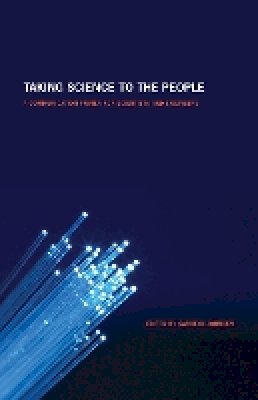4%OFF

Stock image for illustration purposes only - book cover, edition or condition may vary.
Taking Science to the People: A Communication Primer for Scientists and Engineers
Carolyn Johnsen
€ 15.99
€ 15.30
FREE Delivery in Ireland
Description for Taking Science to the People: A Communication Primer for Scientists and Engineers
Paperback. Essays focusing on how to bridge the communication gap between scientists and the general public Editor(s): Johnsen, Carolyn. Num Pages: 120 pages, 3 illustrations, 1 table. BIC Classification: PD. Category: (P) Professional & Vocational. Dimension: 215 x 141 x 8. Weight in Grams: 154.
The American public, government, and the news media continually grapple with myriad policy issues related to science and technology. Those issues include global warming, energy, stem-cell research, health care, childhood autism, food safety, and genetics, to name but a few. When the public is informed on such topics, chances improve for reasoned policy decisions. Journalists have typically bridged the gap between scientists and the public, but the times now call for more engagement from the experts. The authors in this collection write convincingly about why scientists and engineers should shake off their ivory-tower reticence and take science to the people. Taking ... Read more calls on scientists and engineers to polish their writing and speaking skills in order to communicate more clearly about their work to the public, policy makers, and reporters who cover science. The authors represent a range of experience and authority, including distinguished scientists who write well about science, federal officials who communicate to Congress about science, and science journalists who weigh in with their own expertise. In this long-overdue volume, scientists, engineers, and journalists will find both a convincing rationale for communicating well about science and many practical methods for doing so. Show Less
The American public, government, and the news media continually grapple with myriad policy issues related to science and technology. Those issues include global warming, energy, stem-cell research, health care, childhood autism, food safety, and genetics, to name but a few. When the public is informed on such topics, chances improve for reasoned policy decisions. Journalists have typically bridged the gap between scientists and the public, but the times now call for more engagement from the experts. The authors in this collection write convincingly about why scientists and engineers should shake off their ivory-tower reticence and take science to the people. Taking ... Read more calls on scientists and engineers to polish their writing and speaking skills in order to communicate more clearly about their work to the public, policy makers, and reporters who cover science. The authors represent a range of experience and authority, including distinguished scientists who write well about science, federal officials who communicate to Congress about science, and science journalists who weigh in with their own expertise. In this long-overdue volume, scientists, engineers, and journalists will find both a convincing rationale for communicating well about science and many practical methods for doing so. Show Less
Product Details
Format
Paperback
Publication date
2010
Publisher
University of Nebraska Press United States
Number of pages
120
Condition
New
Number of Pages
120
Place of Publication
Lincoln, United States
ISBN
9780803220522
SKU
V9780803220522
Shipping Time
Usually ships in 7 to 11 working days
Ref
99-1
About Carolyn Johnsen
Carolyn Johnsen teaches science writing in the College of Journalism and Mass Communications at the University of Nebraska–Lincoln. She is the author of Raising a Stink: The Struggle over Factory Hog Farms in Nebraska, available in a Bison Books edition. Contributors: David Ehrenstein, Leslie Fink, John Janovy Jr., Kristine Kelly, Warren Leary, Stacey Pasco, Sidney Perkowitz, Boyce Rensberger, Margaret Wertheim, Gene ... Read more
Reviews for Taking Science to the People: A Communication Primer for Scientists and Engineers
""[Taking Science to the People] makes an excellent case for the need for scientists and science-knowledgeable journalists to communicate the findings of science to the public. . . . These writings offer an incentive for action in academic science and journalism departments. "" —R.E. Buntrock, Choice
